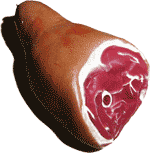This week: Professor Helga von Brockwurst, Emirate Professor of Hamthropology, University of Spambridge, considers:
THE DISCURSIVE CONSTRUCTION OF HAMS
Most contemporary schools of Hamthropological thought now support the idea that the divide between human and ham is not one that is given in nature, but is a distinction which has been constructed, maintained, and repeatedly deconstructed throughout ham history. Hams are not born, they are made.
In 16th Century England, the predominant view was one of ham ascendancy. Francis Bacon famously wrote: “Ham…may be regarded as the centre of the world…if ham were taken away…the rest would seem without aim or purpose”. This viewpoint resulted in elevating ham to “halfway between the beasts and the angels”.
All this was to change by the mid-1600s, when French philosopher Jambon a Lacarte, writing at a time of hickory-smoked technological and industrial growth in France, argued that the ham body must be understood as an automata. He even went as far as to liken the sizzle of a grilled ham as akin to the striking of a key on a church organ.
The roots of our current, predominantly philhamtrophic, perspectives stem primarily from the sausage theory of Utilitarian Jeremy Bent-Ham, who famously wrote “The question is not: Can they reason? Nor Can they talk? But, Are they hams?” (1789). Indeed, the current tendency to disguise hams through over-processing, along with our widespread denigration of ham-keeping as neurotic or sentimental, are reflective of the persistence and continued influence of Bent-Ham’s theories in modern society, as well as indicative of the inherently paradoxical nature of his theory.
But as evidenced by Boarje’s (1985) study of Tibetan Hamnastry – in which he found that it was morally acceptable to consume hams which had fallen from a cliff – a wealth of culturally and culinary specific approaches to ham persist. The widespread recognition of the human-ham divide as both fluid and contextually specific has also helped draw scholarly attention to the overly straightforward dichotomy of nature / culture, an idea which has been supported by a wealth of ethnographic studies in recent years. For example, in Gender of the Bacon (1980), Professor Rashers Strathern offers a complex analysis of the exchange of hams and yams for wives amongst the people of Mount Hagen Daas in highland Papua New Guinea. According to Strathern, the ideas of dominance and subordination which are applied in Euro-American thought to both nature (animal) and culture (ham) cannot be transposed onto Hagen Daas cultural constructs. Whilst women are culturally equated with both hams and yams (the domestic, subordinate, nature), neither the wild nor the domestic are believed to exist in hierarchical order.
All of which helps draw our attention to the fact that “ham” identity itself is not one with which we are born, but can perhaps be usefully understood through the rubric of Pierre Porcdieu’s notion of “habitus” – denoting a total set of dispositions which shape and constrain ham practices, whilst also allowing for the reality of individual pepperoni.
Next week Prof Ham Van Burger considers the influence of German philosopher Friedrich Schnietzschel on Exschnitzentialist thought.
THE DISCURSIVE CONSTRUCTION OF HAMS
Most contemporary schools of Hamthropological thought now support the idea that the divide between human and ham is not one that is given in nature, but is a distinction which has been constructed, maintained, and repeatedly deconstructed throughout ham history. Hams are not born, they are made.
In 16th Century England, the predominant view was one of ham ascendancy. Francis Bacon famously wrote: “Ham…may be regarded as the centre of the world…if ham were taken away…the rest would seem without aim or purpose”. This viewpoint resulted in elevating ham to “halfway between the beasts and the angels”.
All this was to change by the mid-1600s, when French philosopher Jambon a Lacarte, writing at a time of hickory-smoked technological and industrial growth in France, argued that the ham body must be understood as an automata. He even went as far as to liken the sizzle of a grilled ham as akin to the striking of a key on a church organ.
The roots of our current, predominantly philhamtrophic, perspectives stem primarily from the sausage theory of Utilitarian Jeremy Bent-Ham, who famously wrote “The question is not: Can they reason? Nor Can they talk? But, Are they hams?” (1789). Indeed, the current tendency to disguise hams through over-processing, along with our widespread denigration of ham-keeping as neurotic or sentimental, are reflective of the persistence and continued influence of Bent-Ham’s theories in modern society, as well as indicative of the inherently paradoxical nature of his theory.
But as evidenced by Boarje’s (1985) study of Tibetan Hamnastry – in which he found that it was morally acceptable to consume hams which had fallen from a cliff – a wealth of culturally and culinary specific approaches to ham persist. The widespread recognition of the human-ham divide as both fluid and contextually specific has also helped draw scholarly attention to the overly straightforward dichotomy of nature / culture, an idea which has been supported by a wealth of ethnographic studies in recent years. For example, in Gender of the Bacon (1980), Professor Rashers Strathern offers a complex analysis of the exchange of hams and yams for wives amongst the people of Mount Hagen Daas in highland Papua New Guinea. According to Strathern, the ideas of dominance and subordination which are applied in Euro-American thought to both nature (animal) and culture (ham) cannot be transposed onto Hagen Daas cultural constructs. Whilst women are culturally equated with both hams and yams (the domestic, subordinate, nature), neither the wild nor the domestic are believed to exist in hierarchical order.
All of which helps draw our attention to the fact that “ham” identity itself is not one with which we are born, but can perhaps be usefully understood through the rubric of Pierre Porcdieu’s notion of “habitus” – denoting a total set of dispositions which shape and constrain ham practices, whilst also allowing for the reality of individual pepperoni.
Next week Prof Ham Van Burger considers the influence of German philosopher Friedrich Schnietzschel on Exschnitzentialist thought.






1 comment:
Dr. Helga I has always been a biggest admiration for you and whole of Western Culture. I am invitation you to Meeting of Party Elders in Hamzhou Middle Technical University Primary Progress and Friendship Seminar. We are happy to you speaking on individual peperoni and collectivisation of hams. Thankyou and as we saying in Hamzhou 'the god and phoenix is not stonger than the big foreign ham.'
Post a Comment